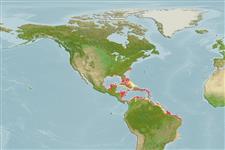Teleostei (teleosts) >
Blenniiformes (Blennies) >
Blenniidae (Combtooth blennies) > Salariinae
Etymology: Parablennius: Greek, para = the side of + Greek, blennios = mucus (Ref. 45335).
More on author: Poey.
Environment: milieu / climate zone / depth range / distribution range
Ecology
Marine; reef-associated; depth range 0 - 10 m (Ref. 9710). Subtropical; 36°N - 27°S, 98°W - 34°W
Western Atlantic: New York (USA), Bermuda, the Bahamas, Gulf of Mexico to southern Brazil.
Size / Weight / Age
Maturity: Lm ? range ? - ? cm
Max length : 8.5 cm TL male/unsexed; (Ref. 7251)
Facultative air-breathing in the genus (Ref. 126274); Adults inhabit eroded basins and limestone boulders covered by an algal mat, sea fans, etc. (Ref. 5521). Sometimes around mangrove roots, young are sometimes found in floating Sargassum (Ref. 26938). Omnivorous, but feed mostly on algae (Ref. 13442). Oviparous. Eggs are demersal and adhesive (Ref. 205), and are attached to the substrate via a filamentous, adhesive pad or pedestal (Ref. 94114). Larvae are planktonic, often found in shallow, coastal waters (Ref. 94114).
Life cycle and mating behavior
Maturities | Reproduction | Spawnings | Egg(s) | Fecundities | Larvae
Oviparous, distinct pairing (Ref. 205).
Robins, C.R. and G.C. Ray, 1986. A field guide to Atlantic coast fishes of North America. Houghton Mifflin Company, Boston, U.S.A. 354 p. (Ref. 7251)
IUCN Red List Status (Ref. 130435)
Threat to humans
Harmless
Human uses
Fisheries: of no interest; aquarium: commercial
Tools
Warning: mysqli::__construct(): (HY000/1040): Too many connections in /var/www/html/includes/speciessummary.lib.php on line 2104
Can't connect to MySQL database fbquizv2. Errorcode: Too many connections
